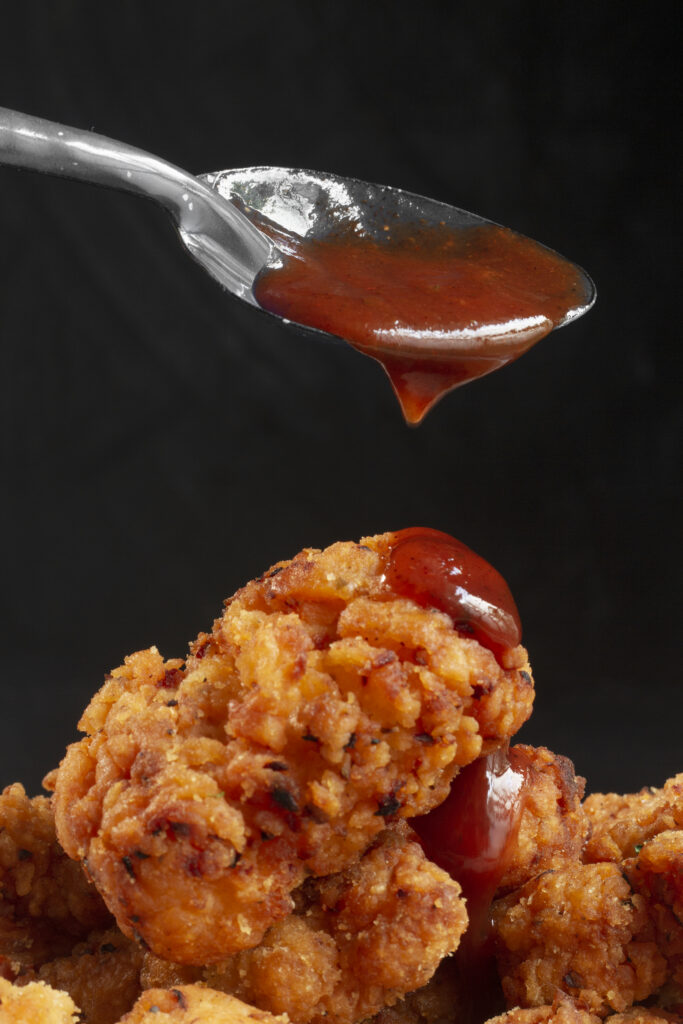Crispy chicken wings tossed in flavorful sauce are a culinary delight. But the challenge lies in maintaining the crispiness of the wings even after saucing. Many people struggle with soggy wings when they add sauce, but the good news is that with the right techniques, you can enjoy perfectly crispy wings every time. This guide provides a detailed roadmap to sauce wings while keeping them crispy, including preparation tips, cooking techniques, and the science behind the perfect sauce application.

Why Do Wings Lose Their Crispiness After Saucing?
The primary reason wings lose their crispiness is moisture. Sauces, especially liquid-heavy ones, introduce moisture to the crispy skin, leading to sogginess.
Common Mistakes:
- Not Drying the Wings Properly:
Moisture on the surface of the wings interferes with the crisping process during cooking. - Using Overly Watery Sauces:
Thin sauces seep into the crispy coating instead of adhering lightly to the surface. - Saucing Too Early:
Adding sauce too far in advance allows it to soak into the crust, softening the wings over time.
Learn more about avoiding sogginess and achieving perfectly sauced wings in our guide to how to get sauce to stick to chicken wings.
Preparing Crispy Wings: The Foundation for Success
Crispiness starts with the right preparation and cooking techniques. Here are the key steps:
1. Dry the Wings Thoroughly
Drying wings is essential to ensure they crisp up during cooking.
- Use paper towels to pat the wings dry on all sides.
- For best results, let the wings air-dry in the refrigerator for 2–4 hours. This step removes excess moisture and helps the skin develop a crunchy texture.
2. Use Baking Powder or Cornstarch
Coating wings with baking powder or cornstarch can significantly enhance their crispiness.
- Baking Powder: Helps break down the proteins on the wing’s surface, creating a crackly crust.
- Cornstarch: Absorbs moisture and creates a light, crispy coating.
For more tips, check out this crispy chicken wings without frying guide for oven and air fryer techniques.
3. Choose the Right Cooking Method
The cooking method you choose directly impacts the crispiness of the wings:
- Baking: Place wings on a wire rack over a baking sheet and cook at 425°F for 40–45 minutes. The wire rack allows heat to circulate evenly, crisping up all sides.
- Air Frying: Cook wings in an air fryer at 375°F for 20–25 minutes, shaking the basket halfway through for even crisping.
- Deep Frying: Fry wings in hot oil at 350°F–375°F for 10–12 minutes. This method guarantees maximum crunch but requires careful monitoring of the oil temperature.
The Perfect Coating for Crispy Wings
A well-applied coating enhances the crispiness of the wings and serves as a foundation for the sauce.
1. Combine Flour and Cornstarch
A 50:50 mix of all-purpose flour and cornstarch creates the perfect coating. Cornstarch adds a light, airy texture, while flour provides structure.
2. Add Spices to the Coating
Incorporate seasonings like garlic powder, paprika, cayenne, and black pepper into the coating mix for a burst of flavor.
3. Double-Coating for Extra Crunch
For an ultra-crispy finish:
- Dip the wings in the flour-cornstarch mixture.
- Let them rest for 5 minutes.
- Dip them in the coating again for a thicker, crunchier crust.
Explore marination and coating techniques in our guide to should I marinate wings before deep frying to perfect your wing preparation.
Preparing the Sauce for Crispy Wings
The sauce’s consistency and application method are crucial for maintaining crispy wings.
1. Thicker Sauces Work Best
Thin, watery sauces can seep into the crispy crust, making the wings soggy. To thicken sauces:
- Add cornstarch or a roux.
- Simmer the sauce over low heat to reduce excess liquid.
- Use butter-based sauces, like buffalo sauce, which naturally cling to the wings.
2. Warm the Sauce Before Use
Hot wings pair best with warm sauces. Heating the sauce helps it adhere evenly and prevents a sudden temperature drop that could soften the wings.
3. Avoid Over-Saucing
- Use a light hand when applying the sauce.
- Toss wings in small batches to ensure even coating without oversaturating.
For more insights, check out Serious Eats’ article on the science of sauce consistency and application.
Tossing Wings in Sauce Without Losing Crispiness
Tossing wings in sauce requires precision. Follow these steps to maintain their crunch:
1. Toss Wings Immediately After Cooking
Freshly cooked wings are more receptive to the sauce and retain their crispy texture when sauced while hot.
2. Use a Large Bowl for Tossing
Using a large mixing bowl ensures the sauce is evenly distributed without saturating the wings.
3. Work in Small Batches
Tossing wings in smaller batches allows better control over the amount of sauce used.
Serving and Storing Sauced Wings
To enjoy crispy, sauced wings at their best, follow these tips:
1. Serve Immediately
Crispy wings are best enjoyed right after saucing. Serving them immediately minimizes the time for the sauce to affect their texture.
2. Reheat Properly
If you need to reheat wings:
- Preheat an oven or air fryer to 375°F.
- Heat the wings for 5–7 minutes to restore their crispiness.
- Avoid microwaves, as they can make the wings rubbery and soggy.
3. Store Leftovers Correctly
Store leftover wings in an airtight container in the fridge. Reheat using the methods above to retain as much crispiness as possible.
Flavor Pairings: Matching Sauces to Crispy Wings
Different sauces pair beautifully with crispy wings, and the right choice can elevate your meal.
1. Buffalo Sauce
This tangy, buttery classic clings well to crispy wings. A hint of honey can add sweetness and help the sauce stick better.
2. Honey Garlic Glaze
A sticky combination of honey, soy sauce, and garlic enhances the wings’ flavor while maintaining their crunch.
3. Barbecue Sauce
Thicker barbecue sauces adhere well without soaking into the crust. Look for molasses-based options for a smoky, sweet flavor.
4. Dry Rubs
If you want to avoid sauce altogether, opt for dry rubs. They offer bold flavors without introducing moisture.
FAQs About Keeping Sauced Wings Crispy
Why do sauces make wings soggy?
Most sauces contain water, which can seep into the crispy crust and soften it. Using thicker sauces or lightly tossing wings helps minimize this issue.
What type of sauce works best for crispy wings?
Thick, sticky sauces like buffalo or barbecue work best. Avoid watery sauces or reduce them to improve their consistency.
Can I sauce wings ahead of time?
It’s better to sauce wings just before serving. If sauced too early, the wings will lose their crispiness.
How can I reheat wings without losing crispiness?
Reheat wings in an air fryer or oven at 375°F for a few minutes to restore their crunch.
Conclusion
Saucing wings while keeping them crispy requires attention to detail, from the preparation of the wings to the choice and application of the sauce. By drying the wings thoroughly, using a proper coating, and applying warm, thick sauces sparingly, you can enjoy perfectly crispy, sauced wings every time.
Try these techniques with your favorite recipes, and explore related resources like fried chicken wings with Italian salad dressing for more inspiration. With these tips, you’ll master the art of crispy, flavorful wings!
